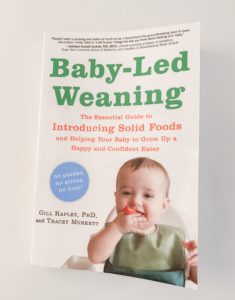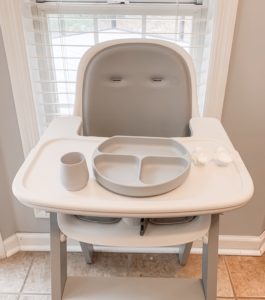Our “why” of Baby Led Weaning is simple: we wanted to eat dinner at the table as a family, letting our baby eat at his own pace, enjoying the full meal experience. (You can find that post here.) The how seemed more complicated.
The how was a little overwhelming at first because there are a few steps involved that aren’t included in the baby purées route. That in combination with the plethora of information via Pinterest made figuring out where to start daunting.
To simplify and summarize the hours of reading and Pinteresting that I did to prepare for BLW, I’ve compiled a starter kit list of things you will need:
(Please note: be sure to read and research for your family, consult with your pediatrician, and go with your mom gut.)
1.Knowledge:
“Knowledge is knowing a tomato is a fruit; wisdom is not putting it in a fruit salad.”
For starters, I read Baby-Led Weaning: The Essential Guide to Introducing Solid Foods and Helping Your Baby to Grow Up a Happy and Confident Eater by Gill Rapley, PhD and Tracey Murkett. To be honest, the concept explanation was as long as the title, but by going through it, I really understood my “why” and “how” better. The authors explained the benefits, when to start, how to prepare food, and shared testimonials. They outline signs of readiness, food preparation guides by mastery level, benefits, success stories, and more. Googling the topic led to information overload, so having all I needed in one source made learning much easier. Starting foods too early, incorrectly prepared foods, pressuring babies, and other factors may set your family up for failure, so I highly recommend finding a true, research-based source to read.

The next piece of knowledge is very important: know the difference between gagging and choking and be prepared to react accordingly. Gagging is a normal part of BLW, especially in the early days when their tongue thrust reflex is still present. Reacting too quickly to a baby that is gagging may lead to them choking if they get scared, so as difficult as it is, it’s important to closely observe and be ready to intervene, but do not react unless your baby is truly choking. If choking, you will need to follow infant heimlich maneuver procedures. Through East Alabama Medical Center, you can register for CPR classes (found here).Honestly, this is the part that made me a little hesitant to choose this route for our family, but before our Sully started foods, we made sure we knew exactly when and how to intervene.
As the saying goes, “knowledge is power,” so find your credible source and get to reading!
2.A Prepared Response for the Naysayers:
“Haters gonna hate, but I don’t CARROT all.” -probably some BLW baby somewhere
If I’ve discovered one thing through pregnancy and now after a year of motherhood, it’s that EVERYONE has an opinion about how you should parent. Becoming a mom has skyrocketed my confidence though, so when someone disagrees with our family’s methods, I have no problem explaining myself. With baby led weaning, it is no different. Because watching a six month old chow down on taco ingredients looks peculiar in our culture, comments will be made to you that baby should not be eating food; she cannot eat food without teeth; or you are putting your baby in danger. I polled a BLW group for their responses on what they tell naysayers, and some of them will definitely be added to my rotation.
“Oh, I’m sorry! I didn’t realize he was your baby! I thought he was mine!”
“Remember when Grandpa took out his dentures and chowed down on that steak…yeah…it’s the same.”
“Wanna bet that my baby can eat more than me?” (and then insert baby eating her entire plate)
Whatever your style-direct, passive, sarcastic, fact based-, I recommend knowing what you are going to say because if your situation is like ours, going to a restaurant or out to eat with family can turn sour if you are caught off guard by their response.
3.Feeding Supplies:
“An apple a day keeps anyone away if you throw it hard enough.”
If mess freaks you out, I would either buckle down and prepare yourself for it or run away. Babies are not born knowing how to feed themselves food:they have wobbly heads, floppy limbs, and awkward movements. Therefore, the first months of feeding are not the cleanest. Getting food to their mouths is new and requires practice which inevitably means a mess is to ensue. As they learn to get food to their mouths, they then begin to test boundaries and discover gravity by dropping food or tossing their plate. As a mom on the end of the weaning process, I can truly attest that all of that gets better! Sully gets food directly to his mouth and knows that food stays on his plate. It took coaching and patience, but he’s a champ at the table!
As a semi-minimalists, our family decided to just have one of each feeding tool. We wanted them to be high quality and meet our feeding needs, so we tried a few before finding just the right ones for us.

Our favorites:
Plate: Bumkins Silicone Suction Plate
Utensils: Grabease Fork and Spoon
Open cup: EZPZ Tiny Cup
Bib: Bumkins Full Upper Body Bib
Hand Vacuum: Black + Decker Dustbuster
Wipes: Up + Up Target Brand Hand and Face Wipes
Some families choose to serve directly on the high chair, others choose to start babies off with an actual plate: in this manner, choose what works best for your dynamic and get ready for a messy but amazing ride!
4.Patience:
“I had my patience tested. I’m negative.”
If someone asked me for one nugget of advice about BLW, I would say to be patient with the process. I knew going in that first, we would not start until Sully was six months and sitting independently which is two months past the suggested age for rice or oatmeal cereal. Secondly, it would put the burden of feeding him on me for longer in terms of his milk consumption. Knowing ahead of time that this was a process and not an instant hunger buster really took all stress out of the process. I never asked myself, “is he eating enough food?” because I knew he was still getting the same amount of milk regardless of what was or was not left on his plate. We practiced eating with him for three months before I ever felt like he was consuming enough to even fill his belly, but once it clicked for him, he ate wonderfully! It was then that he started dropping bottles which took some of the work off of me, and knowing that ahead of time never led me to pressure him to eat or cause me to fret over his meals. Remember, it is called BABY led weaning for a reason, and the focus is truly on your child and his or her pace of learning to eat.
In all seriousness, watching my son grow as a confident and opinionated eater has been an incredible experience. Every bit of mess, annoyance from the naysayers, and small amount of fear was completely worth it. He is now eating three meals a day and two snacks, and life is much simpler: there is little mess; he is not picky at all; and I am weaning myself off of my pump because he has dropped bottles. If you’re on the fence about baby led weaning, I strongly encourage you to find a book, a blog, or contact me! I’m more than happy to explain what worked for our family.











